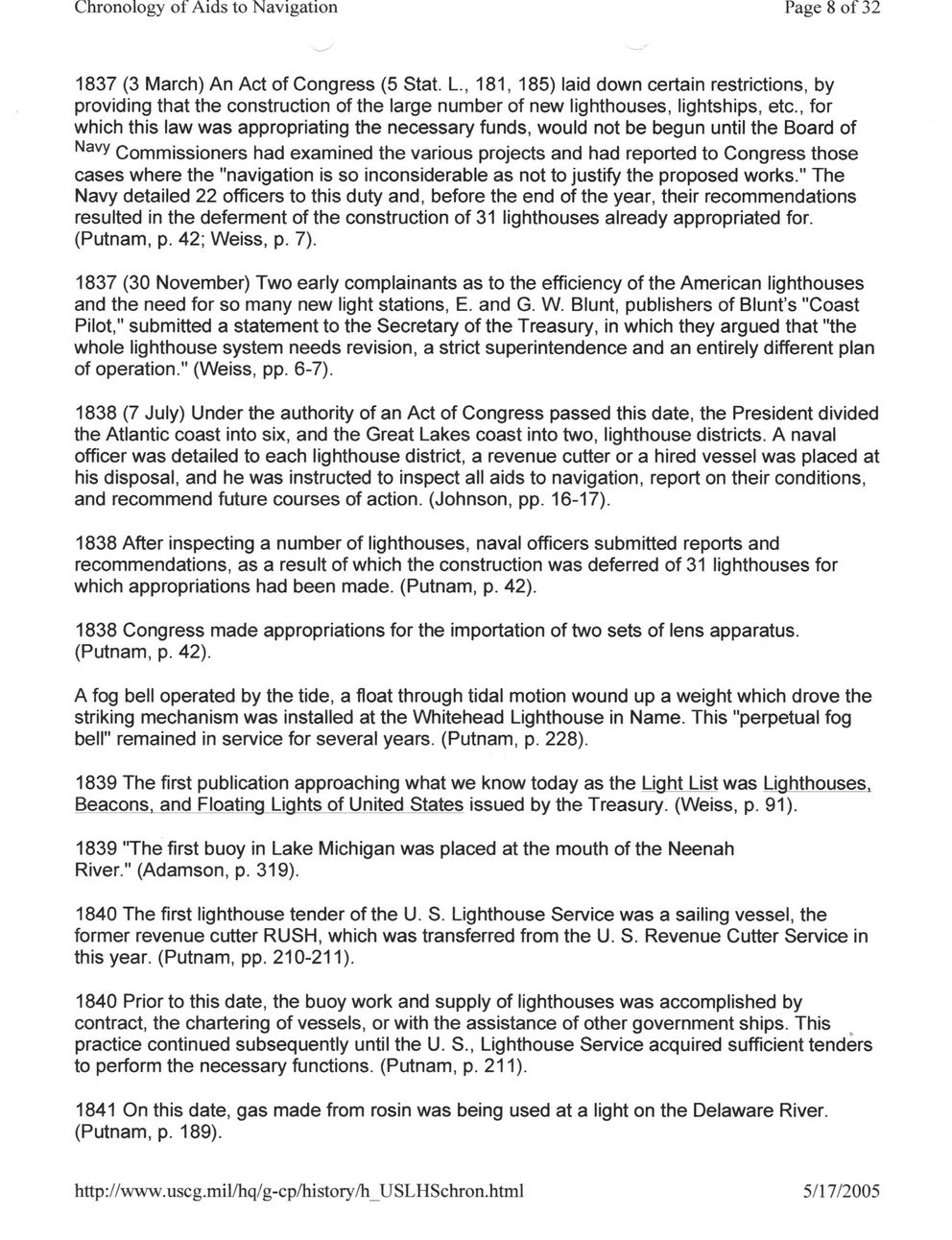This text was obtained via automated optical character recognition.
It has not been edited and may therefore contain several errors.
Chronology of Aids to Navigation Page 8 of 32 1837 (3 March) An Act of Congress (5 Stat. L., 181, 185) laid down certain restrictions, by providing that the construction of the large number of new lighthouses, lightships, etc., for which this law was appropriating the necessary funds, would not be begun until the Board of Navy Commissioners had examined the various projects and had reported to Congress those cases where the "navigation is so inconsiderable as not to justify the proposed works." The Navy detailed 22 officers to this duty and, before the end of the year, their recommendations resulted in the deferment of the construction of 31 lighthouses already appropriated for. (Putnam, p. 42; Weiss, p. 7). 1837 (30 November) Two early complainants as to the efficiency of the American lighthouses and the need for so many new light stations, E. and G. W. Blunt, publishers of Blunt’s "Coast Pilot," submitted a statement to the Secretary of the Treasury, in which they argued that "the whole lighthouse system needs revision, a strict superintendence and an entirely different plan of operation." (Weiss, pp. 6-7). 1838 (7 July) Under the authority of an Act of Congress passed this date, the President divided the Atlantic coast into six, and the Great Lakes coast into two, lighthouse districts. A naval officer was detailed to each lighthouse district, a revenue cutter or a hired vessel was placed at his disposal, and he was instructed to inspect all aids to navigation, report on their conditions, and recommend future courses of action. (Johnson, pp. 16-17). 1838 After inspecting a number of lighthouses, naval officers submitted reports and recommendations, as a result of which the construction was deferred of 31 lighthouses for which appropriations had been made. (Putnam, p. 42). 1838 Congress made appropriations for the importation of two sets of lens apparatus. (Putnam, p. 42). A fog bell operated by the tide, a float through tidal motion wound up a weight which drove the striking mechanism was installed at the Whitehead Lighthouse in Name. This "perpetual fog bell" remained in service for several years. (Putnam, p. 228). 1839 The first publication approaching what we know today as the Light List was Lighthouses, Beacons, and Floating Lights of United States issued by the Treasury. (Weiss, p. 91). 1839 "The first buoy in Lake Michigan was placed at the mouth of the Neenah River." (Adamson, p. 319). 1840 The first lighthouse tender of the U. S. Lighthouse Service was a sailing vessel, the former revenue cutter RUSH, which was transferred from the U. S. Revenue Cutter Service in this year. (Putnam, pp. 210-211). 1840 Prior to this date, the buoy work and supply of lighthouses was accomplished by contract, the chartering of vessels, or with the assistance of other government ships. This practice continued subsequently until the U. S., Lighthouse Service acquired sufficient tenders to perform the necessary functions. (Putnam, p. 211). 1841 On this date, gas made from rosin was being used at a light on the Delaware River. (Putnam, p. 189). http://www.uscg.mil/hq/g-cp/history/h_USLHSchron.html 5/17/2005

Lighthouses Chronology-of-Aids-to-Navigation-(08)